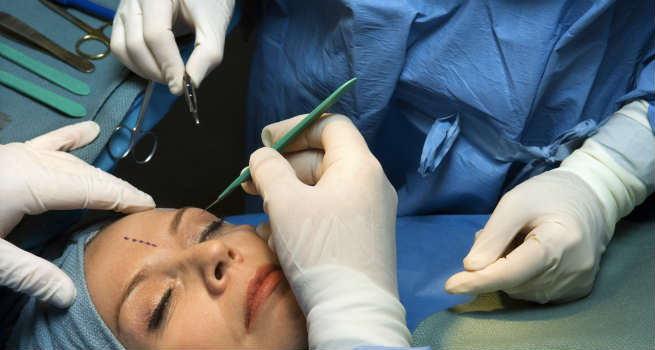Dealing with the visible signs of aging on our face and neck can be challenging, right? Nobody wants the telltale signs of aging like sagging cheeks, a drooping jawline, and a less defined neckline. Unfortunately, aging is a natural process, and we can’t stop it to maintain a forever-young appearance. That’s where procedures like a ‘facelift’ come into play. It’s a widely practiced method globally to combat the loss of youthful facial contours. Over the years, it has evolved to provide more natural, rejuvenated, and longer-lasting results. You’re in the right place if you’re still curious about a facelift. Let’s explore everything about it in this article.
What Is A Facelift?
A ‘Facelift Surgery’ or ‘Rhytidectomy’ (as termed medically) is a cosmetic surgery that gives a youthful appearance by reducing wrinkles, improving muscle tone, and firming the skin. It helps you deal with the loose and sagging skin all over the face, including the creases along the smile line, nose, and jowls. A facelift usually works on reshaping the lower one-third of the face and takes years off the face by removing excess skin. Even the deeper tissue of the face is tightened by pulling the skin gently in an upward and posterior direction. (1)
Who Can Get A Facelift Done?
A facelift surgery is a fantastic way to rejuvenate the entire appearance by making the skin look taut and toned. But, it is not the only treatment to offset the aging process and is not for everyone. Once you contact a reputed surgeon, they will advise you whether it is necessary or you can opt for other non-surgical facial treatments. On the other hand, an ideal candidate for facelift surgery should have the following traits or qualities for successful outcomes: (2)
- Good overall health and physical fitness
- A naturally supple skin with good elasticity
- A solid and well-defined bone structure
- Excess and loose skin on the face and neck
- No habit of smoking and drinking
- Realistic expectations about the outcomes
How Is The Facelift Surgery Done?
Now, let us see what is done during the surgery. The following are the steps involved: (3)
- The surgery begins with the administration of anesthesia, which typically includes general anesthesia and intravenous sedation.
- Based on the degree of changes required and desired by the candidate, the best technique is chosen from the three most common types of facelifts, i.e., ‘traditional facelift,’ ‘limited incision facelift,’ and ‘neck lift.’
- In the traditional method, an incision is made in the hairline near the temples, which proceeds to the front of the ears. It then goes under the ears, upwards behind it, and ends in the hairline in the lower scalp.
- The fatty tissue and the skin along this incision are lifted off. The fat may be sculpted and redistributed around the skin if you want a fuller face.
- The underlying connective tissue and the muscles in the deeper layers of the face are lifted, repositioned, and tightened.
- The skin is then pulled back over the uplifted contours so that it is tightened over the muscles. Also, the excess skin is trimmed off at the edge of the incision.
- Finally, the incisions are sealed with sutures or skin adhesives.
Downtime And Recovery
Recovering from a facelift typically takes around a couple of weeks, and you can gradually resume more vigorous activities after four weeks. Your skin will be bandaged post-surgery to minimize swelling, bruising, or bleeding. Following proper washing and bathing instructions is crucial to keep the incisions and bandages dry. You might need oral medication or topical treatments to alleviate discomfort, tenderness, and pain. Experiencing numbness and muscle stiffness is quite common during this period. Usually, you’ll be off bandages and medications within a week, and the sutures will be removed within 5-10 days.
The incisions in a facelift surgery are created strategically so that they are not visible easily. They are mostly hidden along the hairline in front of the face or in specific facial creases in front of the ears.
Also Read –How Does Breast Lift With Fat Transfer Work? Get All The Details Here!
Results Of The Surgery
Facelift surgery promises a firmer, smoother, and more youthful appearance; most patients find the results satisfying. It makes the skin taut by eliminating droopiness from the cheeks and the jawline. It also reduces the creases from the corners of the lips by lifting them.
Duration And Longevity
The surgery can last from two to five hours, depending on the results you wish to achieve. The results of the surgery can last as long as ten years. However, quitting smoking and drinking, following a robust exercise routine, and maintaining a healthy lifestyle can help you extend it even more.
Also Read –Restore The Contours Of Your Face Via An AccuLift
Risks And Complications
If you have decided to undergo a facelift, consult a reputed surgeon to avoid potential complications. Though it is a safe procedure, some infrequent risks associated with it include:
- Bleeding
- Bruising
- Inflammation
- Numbness
- Scarring
- Infections
- Hematoma
- Facial asymmetry
- Skin necrosis
- Neurological dysfunction
- Widening or thickening of scar
- Hair loss around the incision
How Much Does A Facelift Cost?
When considering a facelift, the typical cost falls in the range of $6,000 to $7,500. However, the actual expense can fluctuate based on factors such as the surgical facility, surgeon’s fees, the complexity of the modifications required, the type of anesthesia, and the specific surgical technique employed. Choosing a reputable surgeon and a quality facility is crucial for achieving effective facial skin rejuvenation and turning back the clock on aging.
Also Read – Is Face Tape For Instant Facelift Effective? We Tell You The Truth!
Caution:
A facelift needs to be performed by a truly skilled surgeon, as removing too much skin can result in a ‘startled ‘ or ‘pulled-back’ look. It can also lead to distorted earlobes. Sometimes, a facelift may need to be accompanied by other surgeries, such as a forehead lift, eyelid surgery, cheek or chin implant, liposuction, autologous fat injection, chemical or laser peel, etc.
Also Read – How Is Facelift Without Surgery Possible? Here Are All Your Options
Summary
Achieving a youthful appearance amidst the challenges of aging is no easy feat. The telltale signs like sagging cheeks, a drooping jawline, and an undefined neckline can be discouraging. Enter the ‘facelift,’ a widely embraced cosmetic procedure designed to combat the loss of youthful facial contours. Over the years, it has evolved to deliver more natural, rejuvenated, and enduring results. This article unfolds the intricacies of a facelift, covering its definition, candidacy criteria, procedural details, recovery insights, benefits, potential risks, cost considerations, and crucial cautionary notes. If a facelift intrigues you, explore this comprehensive guide to reclaiming a more youthful visage.


